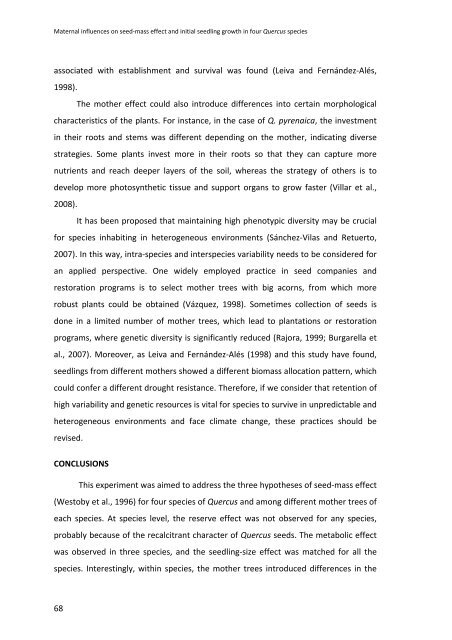Establecimiento de cuatro especies de Quercus en el sur de la ...
Establecimiento de cuatro especies de Quercus en el sur de la ...
Establecimiento de cuatro especies de Quercus en el sur de la ...
Create successful ePaper yourself
Turn your PDF publications into a flip-book with our unique Google optimized e-Paper software.
Maternal influ<strong>en</strong>ces on seed‐mass effect and initial seedling growth in four <strong>Quercus</strong> species<br />
associated with establishm<strong>en</strong>t and <strong>sur</strong>vival was found (Leiva and Fernán<strong>de</strong>z‐Alés,<br />
1998).<br />
The mother effect could also introduce differ<strong>en</strong>ces into certain morphological<br />
characteristics of the p<strong>la</strong>nts. For instance, in the case of Q. pyr<strong>en</strong>aica, the investm<strong>en</strong>t<br />
in their roots and stems was differ<strong>en</strong>t <strong>de</strong>p<strong>en</strong>ding on the mother, indicating diverse<br />
strategies. Some p<strong>la</strong>nts invest more in their roots so that they can capture more<br />
nutri<strong>en</strong>ts and reach <strong>de</strong>eper <strong>la</strong>yers of the soil, whereas the strategy of others is to<br />
<strong>de</strong>v<strong>el</strong>op more photosynthetic tissue and support organs to grow faster (Vil<strong>la</strong>r et al.,<br />
2008).<br />
It has be<strong>en</strong> proposed that maintaining high ph<strong>en</strong>otypic diversity may be crucial<br />
for species inhabiting in heterog<strong>en</strong>eous <strong>en</strong>vironm<strong>en</strong>ts (Sánchez‐Vi<strong>la</strong>s and Retuerto,<br />
2007). In this way, intra‐species and interspecies variability needs to be consi<strong>de</strong>red for<br />
an applied perspective. One wi<strong>de</strong>ly employed practice in seed companies and<br />
restoration programs is to s<strong>el</strong>ect mother trees with big acorns, from which more<br />
robust p<strong>la</strong>nts could be obtained (Vázquez, 1998). Sometimes collection of seeds is<br />
done in a limited number of mother trees, which lead to p<strong>la</strong>ntations or restoration<br />
programs, where g<strong>en</strong>etic diversity is significantly reduced (Rajora, 1999; Burgar<strong>el</strong><strong>la</strong> et<br />
al., 2007). Moreover, as Leiva and Fernán<strong>de</strong>z‐Alés (1998) and this study have found,<br />
seedlings from differ<strong>en</strong>t mothers showed a differ<strong>en</strong>t biomass allocation pattern, which<br />
could confer a differ<strong>en</strong>t drought resistance. Therefore, if we consi<strong>de</strong>r that ret<strong>en</strong>tion of<br />
high variability and g<strong>en</strong>etic resources is vital for species to <strong>sur</strong>vive in unpredictable and<br />
heterog<strong>en</strong>eous <strong>en</strong>vironm<strong>en</strong>ts and face climate change, these practices should be<br />
revised.<br />
CONCLUSIONS<br />
This experim<strong>en</strong>t was aimed to address the three hypotheses of seed‐mass effect<br />
(Westoby et al., 1996) for four species of <strong>Quercus</strong> and among differ<strong>en</strong>t mother trees of<br />
each species. At species lev<strong>el</strong>, the reserve effect was not observed for any species,<br />
probably because of the recalcitrant character of <strong>Quercus</strong> seeds. The metabolic effect<br />
was observed in three species, and the seedling‐size effect was matched for all the<br />
species. Interestingly, within species, the mother trees introduced differ<strong>en</strong>ces in the<br />
68

















